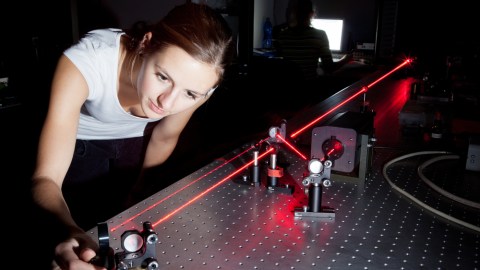The SmallCap and Gown: How Early Stage NewSpace Start-ups Leverage Universities

NewSpace SmallCaps often face challenges: tight budgets, game-changing competition, lengthy development schedules and cash flow crunches. To reduce some of this pain, NewSpace companies have found significant advantages in tapping universities for talent, but more importantly, they have redefined the relationships with universities as customers rather than merely as partners.
Universities as Customers
During the nascent stage of the industry and prior to larger scale market adoption, NewSpace companies seek to have universities as their customers when seeking revenue generation through markets, the 2nd screen of the “NSG 4-Screens.” A prime example of a NewSpace SmallCap that has found financial success (largely in the 4th of the “8-Verticals of NewSpace”) by signing universities as customers is NanoRacks. NANO has landed academic customers – both domestic and international – to support the viability of its business model. NANO ended 2011 as a 4th tier NSG 100 due primarily to problems associated with the 2nd Vertical (Launch Vehicle Providers). (Please see “Exit Strategy / Escape Velocity” in the Premiere issue of Thruster.) Since then, however, the company has seen its NSG 100score skyrocket and is now firmly planted in the 1st tier of the index. Although technological milestones and capitalization events have influenced NANO’s ranking, management’s ability to tap a diversified customer base has also played a significant role in the score boost.
Specifically, NANO has signed customers from the ranks of universities and high schools by organizing the transport of research payloads to the International Space Station (ISS). NSG recently interviewed Richard Pournelle, NANO Senior Vice President of Business Development, who told us that the company took in approximately $1Mln in revenue from academic customers last year. Besides operating within the Microgravity Research Vertical of the “8-Verticals of NewSpace,” NANO was also active in the Launch Vehicle Providers Vertical, as the first NewSpace company to provide commercial CubeSat launches from the ISS. “We’ve already sold out all of our slots for this year,” Pournelle explained. “The average time for a customer signing to a customer flying to space now is about eight months. This allows universities to do research that fits in within an academic year, so a school doesn’t have to worry about the student graduating and having to put together a whole new team, as they’re waiting to put together a flight to space.” (Please see “LargeCap Review” in this issue of Thruster.)
One of NANO’s customers is FPT University of Hanoi, Vietnam, where a student-built nanosat F-1 will track atmospheric changes and possibly shipping traffic and forest fires; NANO recently launched FPT University’s nanosat from the ISS on October 4. This changes the academic research paradigm significantly, and can lead to increased business with universities.
Universities as Talent Hubs
“Universities are an outstanding pipeline of new talent,” said David King, Dynetics Executive Vice President of Integrated Systems and Special Programs, whom we recently interviewed. DYNT, which in addition to operating in the Spacecraft Vertical of the “8-Verticals of NewSpace,” also functions in the In-Space Services and Microgravity Research Verticals. (Please see “Leaders of NewSpace” in the October 2012 issue of Thruster.) King continued, “As they are coming up through the ranks of the universities, we try to get talent working on ‘real world’ problems.” Steve Cook, DYNT’s Director of Space Technologies said that when seeking prospective employees, the company looks for well-rounded people with a high grade point average, and experience in the field (preferably already gained through an internship at the company). DYNT recently reached a teaming agreement with NSG 100 Moon Express regarding DYNT’s Google Lunar X PRIZE contender Rocket City Space Pioneers; as a result of this announcement, ME gained 1.64 points and rose to rank #11 on the NSG 100.
David King, EVP of DYNT
Curt Bilby, President and CEO of biotechnology company Terapio, an NSG OTB (whose research on ameliorating the effects of radiation on the human body could be important in understanding how to protect humans in space) brought up the importance of the experience one can acquire by working with a university: “You get a lot of good thought, especially with some of the post-docs and professors who are so steep and deep in their knowledge.” (Please see “Space Scalable” in the December 2012 issue of Thruster.)
However, NewSpace SmallCaps face a unique challenge: losing the most promising new talent to larger companies. John Garvey is the founder and CEO of NSG 100 Garvey Spacecraft Corporation, based on the campus of Cal State Long Beach (CSLB). (Please see “Leaders of NewSpace” in the July / August 2012 issue of Thruster.) Garvey explains, “Once we have developed a top performer there is the ever-present concern that they will be grabbed by one of the big aerospace organizations.” CEO and Chief Scientific Officer William “Red” Whittaker of NSG OTB Astrobotic, a company located on the campus of Carnegie Mellon University (CMU) that is building lunar robotics and lunar landers, finds a student’s value is high. In his words, “Students are in incredible demand, with or without Astrobotic, or working at another company.”
Besides the human capital of interns, new hires and faculty, the knowledge capital from research and development is also important for a NewSpace SmallCap. DYNT’s Cook explained the characteristics of what he looks for in a partnership with a school, “[Universities] have specific expertise in basic areas, especially in fundamental research – the Low Technology Readiness Level (TRL) types of research. We’re here to make a profit. Typically, we’re not going to have folks doing fundamental research. We’re going to utilize universities which have people and focus where there is Low TRL.” Typically, it is government that funds fundamental research, while NewSpace companies focus on more specific, higher-level research and development.
Universities as Knowledge Banks
Working with academia can reduce some of the costs associated with R&D for NewSpace SmallCaps. President and CEO Eric Golden of Equipois, an NSG 100 maker of ergonomic equipment for manufacturing, said several hundred thousand dollars over the past five years were saved by partnering with academic institutions. (Please see “Down-To-Earth” in the March 2012 issue of Thruster.) When considering a partnership, King of DYNT stressed it is also important that universities in general pay more attention to the business sector and what is happening to businesses, and their day-to-day research needs. Research can be subcontracted to universities by NewSpace companies, or vice versa, and sometimes joint proposals are developed. NSG-tracked companies might also offer universities stock in their company during negotiations.
Working with academia does bring pitfalls, however. To avoid them, Garvey said you have to find the right person to work within the university bureaucracy, “If you don’t have somebody inside actively championing and supporting you [through the administrative processes], doing the tackling and blocking, things could get lost in the system or be pursued in a more casual manner.” Golden added, “Large universities have their own bureaucratic process and sometimes you have to be patient, as when dealing with a large customer. You need to understand their processes and be patient with them.”
Further Benefits to Universities
Although NewSpace SmallCaps can benefit from their relationships with universities, the benefit is mutual. Dr. Juan Sanchez, Vice President for Research at the University of Texas at Austin, who works with TEPO, explained, “In my experience, working with industry exposes our students and faculty to the challenges of the business world and brings to the table the significant talent and intellectual resources of research universities.”
Moreover, universities may have special divisions working on similar problems that NewSpace SmallCaps face. For example, POIS actively works with ergonomic centers across the U.S., including those at Texas A&M and Ohio State. Dr. Mark Benden CPE, Assistant Professor and Co-Director of the Ergonomics Center at the Texas A&M University Health Science Center School of Rural Public Health, echoed the benefits of the synergy between universities and business, like others have expressed in this article.
As the industry grows, universities which support NewSpace SmallCaps as customers, talent sources, and R&D levers, will foster relationships with companies that stand to produce scientific breakthroughs and financial gains. This long-term investment is critical for the survival and the growth of the industry, especially with respect to those NSG 100 and NSG OTB SmallCaps whose capital constraints often prevent them from competing with their well-capitalized and more mature peers of traditional space. There is no reward without some risks. In speaking with several executives from NewSpace SmallCaps, it is clear that those companies that work with universities increase their chances of survival in the short term, and those universities that support such ventures position themselves favorably as the industry matures. One day, some of these companies may even graduate wearing large caps.
David Bullock was the publisher of online digital edition Space Lifestyle Magazine and is a first-time contributor to Thruster.





